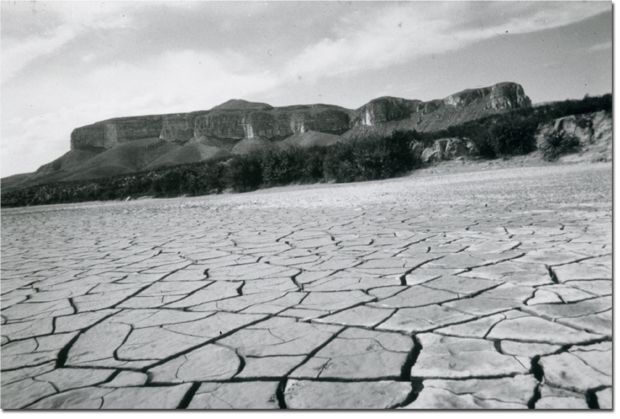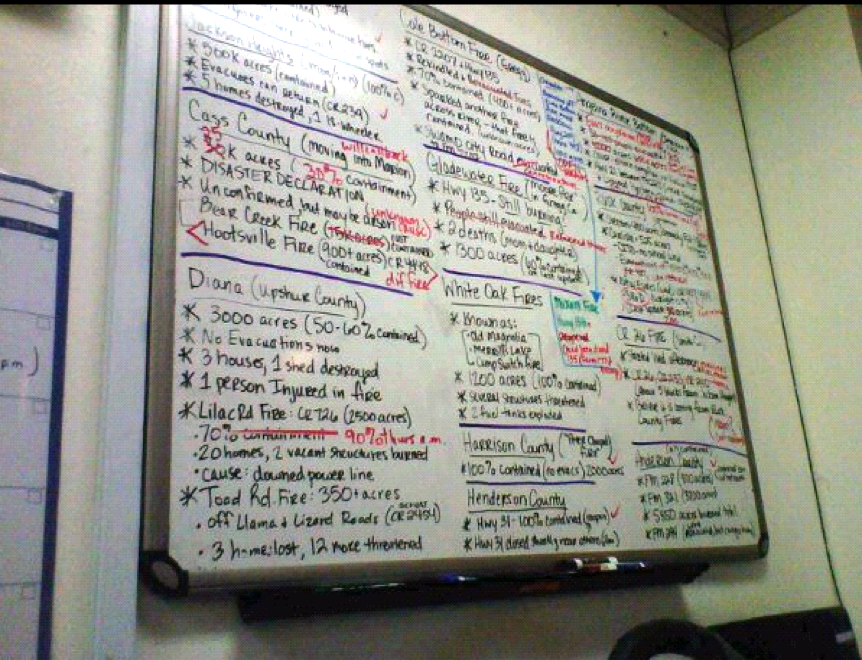Water, Water, Nowhere. And Not a Drop to Drink
Like the guy who forgets his leaky roof when the rain stops, we keep thinking the worst is over. But thanks to climate change, it never will be.

My apologies to Coleridge for bastardizing the most famous line from The Rhyme of the Ancient Mariner, but when it comes to water in Texas, we are up the creek without a creek.

The photo above is a TV newsroom assignments board in Tyler in 2011. The drought that year was the worst in decades. 2011 was the driest year ever for Texas, with an average of only 14.8 inches of rain. 2011 also set new records for low rainfall from March through May, and again from June through August. The high summer temperatures increased evaporation, further lowering river and lake levels. By 2014, 70% of the state was still in a drought.

The result, you see on that assignment board. It is all fires. Half the state was literally on fire. For at least a month and a half, we didn't have to give our reporters actual, specific assignments. They simply grabbed their cameras, a set of car keys and started driving the area looking for smoke. That was their story that night.
And the spillover effect put the kibosh on that year's hunting seasons, caused rationing in virtually every city large and small in the state and caused the leaders of Texas to begin planning for the future. OK, that last one was a lie. The Texas legislature couldn't plan a dinner for two, much less ensure there is ample water for all of us.


And it's not like this was a freak event. A seven-year drought in the 1950's made national news and destroyed over 100,000 farms and ranches. That's when the Texas Water Development Board was created, and to be fair, dams and reservoirs began springing up around the Lone Star State. Then we got a rainy year, then another dry one, and so on for the next 3 decades. And like the guy who forgets his leaky roof when the rain stops, we keep thinking the worst is over. But thanks to climate change, it never will be.
And of course, here we are again. The worst of the current drought is affecting the western part of the state, particularly the Panhandle. Now, of course, 71% of the Earth is covered in water - but sometimes, we don't find it where we need it most.

When I was a TV News Director in Amarillo a couple of years ago, we partnered with the Texas Water Foundation for a series of stories that examined how water affects the region.
We called it The Panhandle Runs on Water, because, well, it does.
It is literally the lifeblood of the entire state, and in the Panhandle, it affects everything people love about living there, from the food they eat to the beer they drink.
This part of Texas sits atop the largest underground lake in the country, the Ogallala Aquifer.

It lies beneath portions of eight states, running from South Dakota to near Midland.
That vital resource is, for lack of a better word, dying.
97% of the water used in the Panhandle comes from the Ogallala, and 90% of that goes to agriculture and irrigation.
That's only part of the water story, however.
Housing developments, growing cities, and manufacturing depend on it. So do restaurants, breweries, and the energy that keeps it all moving.
Whatever your world looks like, Texas, and certainly the Panhandle, runs on water.
And the aquifer they rely on is being drained faster than nature can replenish it.
Compounding the problem, the western United States, particularly the Southwest is also entering an extended period of drought - what experts call an “exceptional drought” - that will cover 20% of the country.

From the eastern Panhandle to most of New Mexico and farther west, the drought will range from severe to exceptional and might last for years.
The southwest overall, got only 25 to 50% of its normal rainfall this year.
You might call it a perfect storm, if that weren’t so ironic.
That means for water, we drill.
Farmers and ranchers need it, the oil and gas industry uses it, and our cities and towns depend on it. During the worst of the dust bowl, the problem wasn't that there was no water. It was that we couldn't get to it. Now we can, with a vengeance. Cities and farms all along the Oglallala are dipping their beaks and ever more efficiently. They know they are sucking a vital resource dry, but they are between a rock and a hard place. It's drill or die.
Unless we conserve or find new sources, the Water Foundation was blunt about it. The Panhandle with dry up and blow away.
And they are only the shallow end of the state's water problems. The Texas Water Development Board found that by 2070 the state's population will grow to 51 million people, 22 million more than today. The state’s annual demand for water, the State Water Board projects, will climb to 21.6 million acre-feet (27 trillion liters), up from 18.4 million.

And, in a drought comparable to the most severe on record, water supplies will fall over the next 50 years from 15.2 million acre-feet to 13.6 million acre-feet (17 trillion liters).
The result is the state needs to find an extra 10 trillion liters of water a year by 2070; the question is how. Add to this, climate change, fire, hotter and longer summers, and dryer winters. An additional complication is the Keystone Cops who run the state. For now, we rob Peter to pay Paul. Dallas is building a 100 mile pipeline to take water from Lake Palestine south of Tyler for their own use. Meanwhile, East Texas is growing as well and will need more water, too.
One good example is Hays County, west of Austin, in the Hill Country. A couple of generations ago, around 40,000 people lived in 14,000 homes there, atop the Trinity Aquifer. Water was plentiful. Now, because we all want a piece of rural Texas, there are 222,000 people in 75,000 homes and they are all thirsty and have pools to fill. The aquifer is tapped out and now they pipe water from Lake Travis to satisfy the new crop of suburban Davy Crocketts.

Part of the issue is we keep building where the water isn't. Like the water wars around Los Angeles, dramatized beautifully in the movie "Chinatown," they built the city and stole enough water to make living in the desert possible, at least for a while.
And doing nothing, which is an Austin specialty, costs money. The 2011 drought, which dragged on for years, and many say is still underway, cost the state $24 billion in direct and indirect losses. In short, the annual $1.89 trillion Texas economy, the second-largest state economy and ninth-largest in the world, is entirely dependent on access to adequate supplies of water.
In an interview with the World Economic Forum, an expert summed it up.
“Texas does not understand shortages,” said Dr. Larry McKinney, one of the state’s top water researchers and the former director of the Harte Research Institute for Gulf of Mexico Studies, a unit of Texas A&M University in Corpus Christi. “It’s the Texas mentality. Texas is so big we’ve had a hard time coming to grips that resources are finite. We really never had to deal with that. Frankly, we’re reaching that point.”
“Water is the economy in Texas,” said McKinney. “It drives everything, particularly as you get less of it.”
Now, far be it from me to interrupt the important work the only Governor we have is doing showing off at the border, regulating who uses what bathrooms and playing Marco Polo with DeSantis, but people are thirsty. We'd like to know that 20 years down the road, we can still turn on the tap and get a glass of agua. The state's 2022 water plan says we need $80 billion in water projects to, well, tread water with our growth. And in the last legislative session, not one water bill passed.
The infrastructure bill passed by the administration makes money available. Can Greg and Dan and the rest of the little rascals swallow their party pride and use it to begin to make sure we have water to drink and grow food? Are you willing to bet your next shower that they can?

And not to put too fine a point on it, but it will get worse. I'll let the climate deniers find some defrocked professor to explain on YouTube why there is no climate change, but I urge everyone else to deal with it. It's here, and will get worse because our national leadership is as spineless as the gang that can't shoot straight in Austin. And while Greg and the boys keep inviting companies to this low tax haven, we don't have the money to provide them with water.
So, while we keep finding ways to cut taxes, the problems pile up. Some people in government haven’t figured out that few things get cheaper and nothing gets younger. Equipment, dams, wells all need tending. Our state has no natural lakes so more reservoirs will be needed, and then filled with water from somewhere.

No one wants to talk about conservation or limiting growth because that is so un-Texan. And certainly, taxes are off the table because no one likes them, either. Well, no one likes Chevy Chase, but he’s still here and won’t go away. Neither will this state’s need for more water. During election years, there’s a lot of wacky talk about holding various feet to various fires. For the sake of the Texas we love, we need to actually do it this time.
